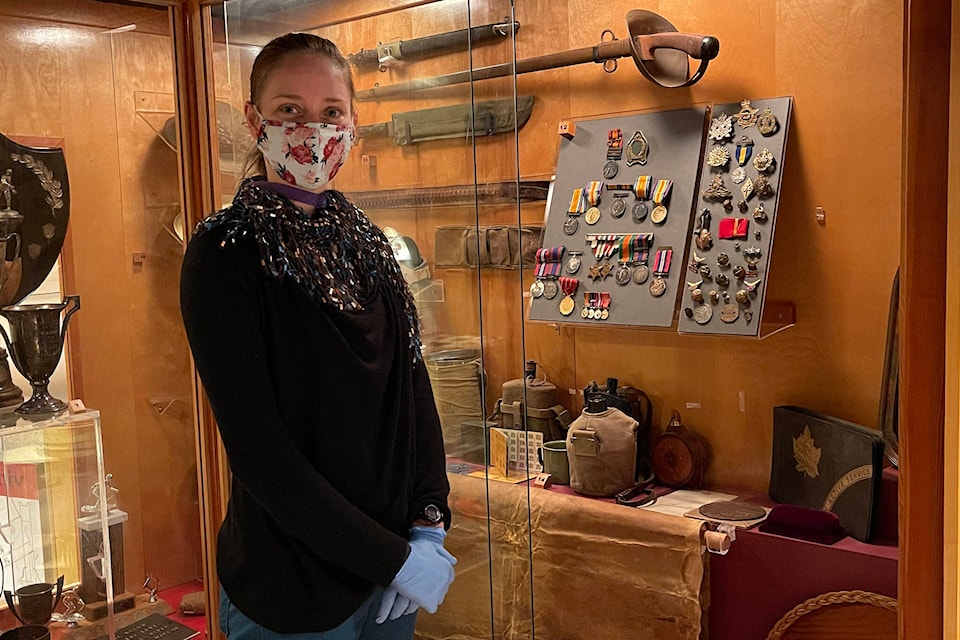As Canada’s war veterans age, the next generations are charged with keeping the memories of those who fought for the country’s freedom. At the Alberni Valley Museum, that means taking care of historical artefacts that have been donated by veterans and their families.
There are a number of wartime items in several different areas of the Wallace Street facility, says museum assistant Amy Vandal. Each carries a story.
There is a Second World War uniform that the late Carl Teichman wore while serving in the Canadian Army’s Second Division as Section Commander. Corporal Teichman was part of the Rocky Mountain Rangers and the Royal Regiment of Canada, serving in the Aleutian Islands and later in the repatriation of France, Belgium and Holland. During the Second World War he landed in Dieppe and marched to Amsterdam, where he was wounded.
The uniform comprises a rifle green wool military jacket and pants. A style called “battle dress,” the uniform was introduced in 1939 and was standard issue until the 1970s.
The uniform is an important artefact for the museum in a number of ways, said Vandal. “We have lots of information about it. For us, having an artefact that is in good condition, it’s great, but if we know the history of the person behind it, it’s more valuable.”
Teichman was born in Dubno, Poland, and emigrated to Prince George, B.C. in 1931. He was a lifetime member of the Royal Canadian Legion and also an auxiliary RCMP officer for a number of years. He was a carpenter at the pulp and paper mill and helped construct many buildings in the Alberni Valley, including the museum at Echo Centre.
Teichman and his wife Audrey loaned the uniform to the museum. Teichman died Dec. 25, 2013. One of the photos included with his obituary shows him wearing a uniform similar to the one in the museum.
READ: War exhibit opens at Alberni Valley Museum
READ: Alberni Valley Museum opens exhibit on Second World War
READ: Students connect with Valley’s war past
In a corner of the second floor of the museum there is a glass display case containing a number of medals and other items pertaining to different world conflicts, from the First and Second World Wars to the Korean War and more. One of the medals was awarded to John Redford, a pioneer settler of Port Alberni, for his participation in the Boer War in South Africa (1899-1902).
The Boer War marked Canada’s first dispatch of troops to an overseas war, according to the Canadian War Museum. Redford was part of the constabulary (S.A.C.), a unit founded in late 1900 when the war changed from a quick ‘march to Pretoria’ into a drawn-out guerrilla campaign.
The regiment served as light cavalry, and Redford’s rank was “trooper”—the cavalry equivalent to an infantry private. Many Canadians served in the S.A.C. since it was a means of seeing action while the Canadian government debated on whether to commit more men to war.
This particular medal, according to information gathered at the Alberni Valley Museum, was awarded to Navy, Army and certain civilians employed in official capacities.
Redford was celebrated on his return to Port Alberni from the war in 1904. He and his brother James farmed the “Scotch Settlement” area of Port Alberni in the late 1880s and a street is named for them. John Redford died in 1950 at the age of 79.
The family of Arthur Thompson donated a canvas first aid “ditty bag” that Thompson carried as a stretcher bearer during the First World War. The canvas bag had been full of cloth bandages, but they fell apart as they were removed so they are not included in any display.
Also known as personal property bags, they were used during the First and Second World Wars as well as the Korean War from 1950-53. They typically contained hygiene items like razor, soap, toothbrush and toothpaste, handkerchief, socks, writing paper and envelopes, Vandal noted.
There is a stain in the corner of the ditty bag, but it is unknown whether the stain came from an item stored in the bag. Vandal said the museum would not remove any stains or marks from items “because that is part of the history.”
Ditty bags were one of the many contributions women made to the war: they were one of the items women from volunteer sewing circles across Canada sewed and knitted for hospital supplies and comfort.
The ditty bag is contained in the textiles section of the museum, but will not be accessible for viewing at this time, as only a portion of the museum’s second floor will be open to the public.
READ: QUINN’S QUIPS: The Alberni Valley Museum is full of cool artefacts, and now you can own one
Teichman’s uniform and other wartime artefacts will be exhibited at the Alberni Valley Museum around Remembrance Day, during regular museum hours.
Anyone interested in “adopting” wartime memorabilia at the museum through the Adopt an Artefact program can ask at the front desk (4255 Wallace St.) or call 250-720-2863 and ask for the museum.
The adoption program began in 2020 as a way to help protect and preserve the history and heritage of the Alberni Valley by way of tax-deductible donations or sponsorship of certain items. Adopters receive an adoption certificate, photo of their item with some information on its history, and are named the adopter for one year. They have first right to continue adoption in following years. They do not get to take the item out of the museum.
There are some items in a catalogue produced for the program, but museum staff are willing to set up an adoption for any artefact of significance to someone.
susie.quinn@albernivalleynews.com
Like us on Facebook and follow us on Twitter
